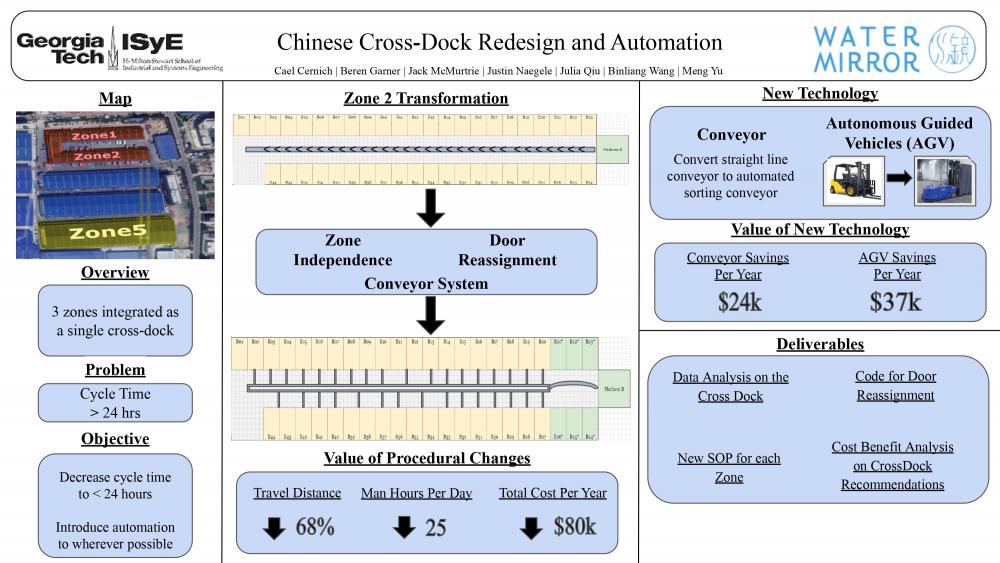Client Context
WaterMirror Technologies, is a small IT company headquartered in China that specializes in next-generation logistics using AI and the theory of the physical internet. They do not own any logistics infrastructure of their own, but they partner with transportation & logistics companies to offer solutions that will improve operations. In this particular scenario, they have teamed up with Heibao Logistics, a Chinese LTL freight carrier, to improve operations at their largest cross-dock in Zhengzhou. Heibao specializes in LTL shipments from manufacturers to businesses throughout China. WaterMirror has optimized flow throughout Heibao’s country-wide network and revised truck schedules. To further improve Heibao’s shipping capacity, the motivation for this project is to improve daily capacity at their largest cross-dock, which routes over 60% of all freight in the network.
Project Objective
The goal of this project is to develop a new freight handling procedure at the Zhengzhou cross-dock. WaterMirror is specifically interested in the application of automated Material Handling Equipment, in keeping with their pioneering vision; however, there are a number of considerations that must be addressed before reaching this point. The facility is divided into 3 zones between 2 buildings. Stack doors assignments group cities geographically, rather than by intensity of flows. A mix of 2 larger conveyor networks and forklifts handle freight staging, which is almost entirely floor-stacked cartons in inbound and outbound trucks. These conveyors have a weight capacity of 20 kgs, so all heavy freight is unloaded in one specific zone. This operational decision leads to a great deal of travel distance in the facility, which we addressed by redesigning the dock assignments. Additionally, Heibao needs to replace one of the conveyor systems urgently, presenting an opportunity for investment. Overall, every process in the facility is reliant on manual labor. Rather than replacing workers entirely, we ought to better facilitate manual workflows using automation.
Design Strategy
For the dock reassignment, the first step was determining the number of strip doors which needed to be allocated to the remaining two zones. This was determined by looking at Gantt charts during peak arrival times to understand the maximum number of simultaneous unloading processes which would occur in the new zones. With that figure determined, we could then benchmark the potential reduction to travel distance using a modified block heuristic. Then, our team developed an excel tool that allows users to compare different arrangements of stack doors in each respective zone. We used this to account for self-imposed constraints, based on the observed statistics from the busiest doors in the old layout.
For the conveyor system, we started by researching the best technologies to use for sorting. Following discussions with our client and the completed strip door redesign, we focused on our design of a new sorting dragline conveyor. Sorting is accomplished using pushers to route RFID-embedded containers, which can hold 1 to 7 parcels, down non-powered roller conveyors. In addition to using RFID for sorting purposes, the design also automates data collection. To reduce costs, the team sought to consolidate sorting lines when possible, based on the low expected utilization of certain sorting lines.
Our team also developed an autonomous workflow, limited to one zone of the facility. Autonomous Guided Vehicles were selected due to their lower cost and the simple nature of the required task. With the new dock assignments, congestion in this area is greatly reduced, with 59% fewer orders picked from here each day. Using this modified arrangement, the team looked at Gantt charts of loading events between these docks to determine the maximum number of simultaneous trips. We used this to account for the absolute highest level of demand required for the AGV system to replace forklift workers in this area.
Deliverables
For the dock reassignment excel tool, we presented and included a number of different layouts for our client. First, we demonstrated that new strip doors could be allocated without exceeding any of the constraints set forth by the previous arrangement. Then, we provided a layout using the block heuristic that similarly does not exceed these constraints. Our client intends to use this tool to experiment with their own arrangements, potentially preserving some of the geographic groupings.
For both the sorting conveyor and AGV designs, our team developed a cost analysis, labor reduction analysis, and visual/written SOP documents.


